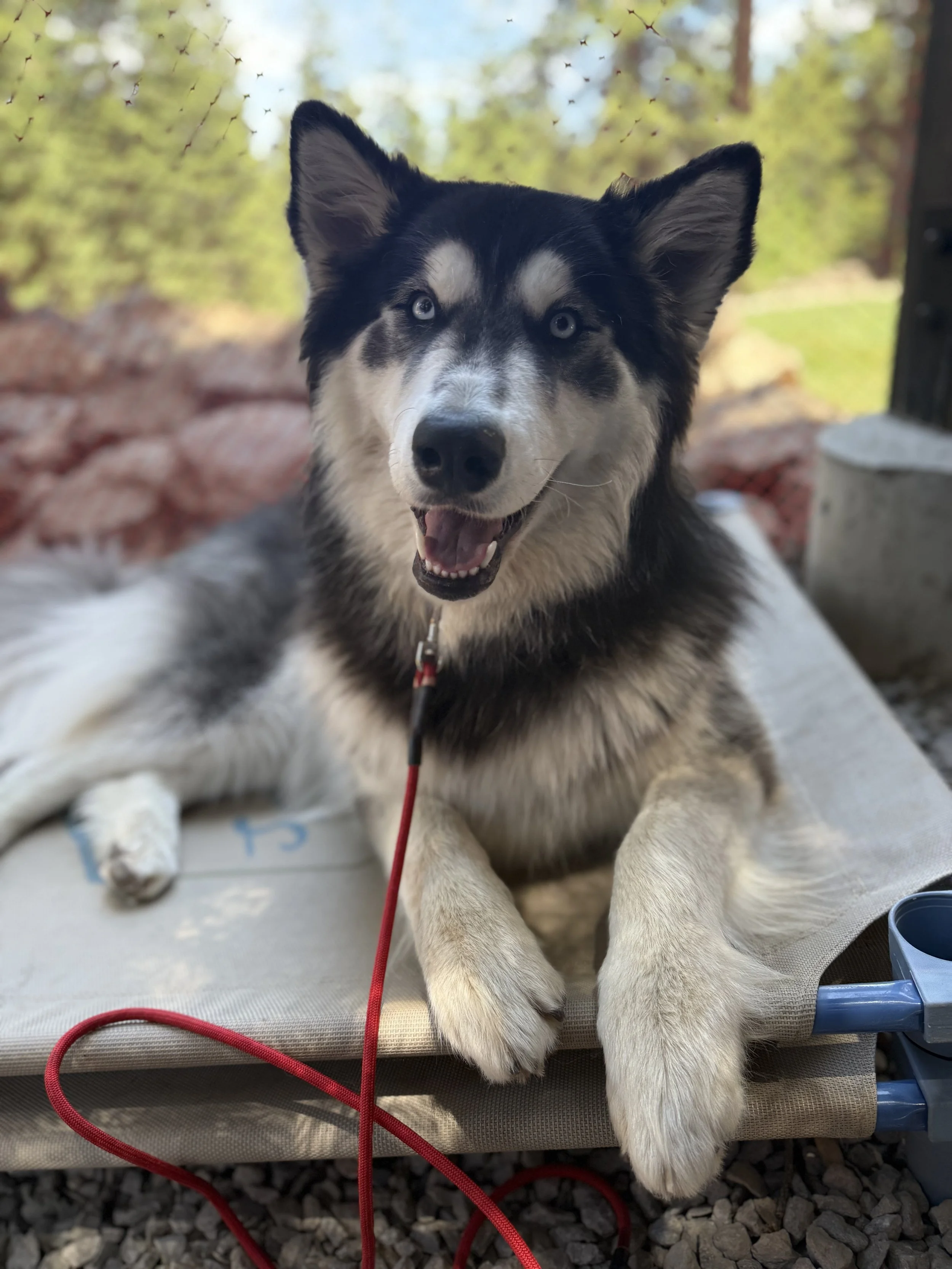The Art of Talking with Your Leash: How Pressure, Release, and Clarity Build Connection
Sierra pictured after her leash work session working on down.
At Skye’s the Limit Dog Training, we believe the leash is far more than a piece of equipment—it’s a communication tool, a translator, and one of the most direct ways to build a working partnership with your dog.
We call it the art of talking with your leash because, when used intentionally, the leash becomes a clear, calm line of communication that taps into the way dogs naturally learn: through physical feedback, cause and effect, and moment-to-moment experience.
Dogs Learn Physically: Pressure and Release is Their First Language
Dogs are physical learners. Long before they associate meaning with human words, they are deeply tuned in to movement, body language, tension, proximity, and the natural forces around them. One of the most foundational systems dogs rely on to understand the world is pressure and release—a simple but powerful cycle of stimulus and resolution.
Pressure is anything that motivates a dog to make a choice or shift behavior. Release is the relief that signals they made the right choice. This feedback loop is happening around your dog every single day, often in subtle ways:
When a person steps closer and the dog backs up—that's spatial pressure and a release.
When the wind rustles leaves and the dog turns to orient—that’s environmental pressure creating curiosity or caution.
When a dog feels a collar tighten as they pull, then loosens when they slow down—that’s direct physical pressure and release.
Even social pressure, such as a prolonged stare from another dog, can guide behavior—often prompting avoidance or de-escalation.
This process is not something we teach dogs—it’s hardwired. Our job as handlers and trainers is not to debate how dogs learn, perceive, or navigate our human world. That part is already written into their biology. The real question is: how do we choose to communicate with them?
For us at Skye’s the Limit, we believe in capitalizing on the way dogs already learn. We use pressure and release intentionally—not to control, but to guide. And when paired with clear verbal markers and consistent reinforcement, this physical language becomes a bridge to human language.
In other words, we use the leash like a Google Translate between species.
Types of Pressure: More Than Just the Leash
Pressure comes in many forms—understanding this helps us communicate more clearly and respectfully:
Physical pressure: Tension from a leash, touch, or the dog’s own movement against a surface.
Spatial pressure: Your presence, body orientation, or movement toward/away from the dog.
Environmental pressure: Sounds, movement, other dogs, traffic, or novel objects that influence your dog’s state of mind.
Social pressure: Eye contact, posture, voice tone, or the presence of unfamiliar people or animals.
Dogs are constantly assessing and responding to these pressures. When we layer our training on top of these existing systems—rather than in opposition to them—we give our dogs a leg up in understanding us. And the leash, when used with intentional timing and direction, becomes the clearest way to begin that conversation.
Leash Pressure as Directional Communication
Dogs don’t come pre-installed with an understanding of words like “heel,” “come,” or “down.” But they do understand movement and feedback. When we use the leash thoughtfully, we can shape behaviors with directional cues that guide rather than overpower.
Here’s how:
A light forward leash pressure can ask the dog to move ahead.
Gentle downward pressure can help a dog understand the concept of a down.
Lateral pressure can shape better heel position.
Backward pressure can signal a recall or redirection.
What matters is the timing: the leash asks, the dog responds, and we release. That release is what reinforces the behavior and encourages the dog to try again next time.
Just like a dance partner responds to a guiding hand, dogs can learn to respond to leash pressure without resistance—if we are clear, consistent, and fair.
From Physical to Verbal: Building the Bridge
Verbal cues are human tools. Dogs are capable of learning them, but not without context. That’s why pressure and release come first—because they offer the clarity dogs need to do the thing we’re asking, even if they don’t yet understand the word.
Once a dog reliably follows leash cues or body prompts, we begin pairing those physical actions with verbal markers. Over time, those words gain meaning through experience—not just repetition. This layered communication builds fluency.
In this way, the leash becomes a temporary scaffold: a way to show, not just tell. As our dogs gain confidence and understanding, we use the leash less and less. But its value in building initial understanding is essential.
Why This Approach Works
It respects the way dogs naturally learn.
It reduces frustration and guesswork.
It increases clarity, which builds confidence.
It builds a reliable connection between you and your dog—even under stress.
It lays the groundwork for verbal understanding and off-leash reliability.
Most of all, it makes training feel like a partnership, not a battle.
Choose Connection Over Control
There’s a misconception in dog training that leash work is about control. At Skye’s the Limit, we believe it’s about conversation.
Dogs don’t come knowing our language—but they are eager to connect. When we learn to use tools like the leash to speak in ways they do understand, we build a bridge—one made of trust, timing, and teamwork.
The leash is not a crutch or a command. It's a translator. And with time, it becomes a guide your dog trusts to lead them through a complex human world with confidence.
Let’s teach our dogs in the language they already speak—and help them learn ours one thoughtful step at a time.
